Abstract
A production-inventory model for a deteriorating item with time-varying demand and fully backlogged shortages is developed for a two warehouse system. For display and storage of inventory, management hires one warehouse of finite capacity at the market place, called own warehouse abbreviated as OW and another warehouse with large capacity as it may be required at a distance place from the market, called rented warehouse abbreviated as RW. Though the time of transporting items from RW to OW is ignored the transportation cost for transporting items is taken to be dependent on the transported amount. Here the objective is to minimize the total cost for a finite planning horizon. A genetic algorithm (GA) is designed to determine the optimum number of production cycles and the cycle times within a finite planning horizon. In this GA a subset of better children is included with the parent population for next generation and size of this subset is a percentage of the size of its parent set. Performance of this GA with respect to some other GAs is compared. Two particular cases (i) with non-deteriorating items and (ii) without shortages are also investigated. Finally, to illustrate the model and to show the effectiveness of the proposed approach, a numerical example is provided. With respect to the demand parameters, a sensitivity analysis is performed and presented. In this paper, we have pointed out that the expression of Lee and Hsu (2009) can be obtained as a particular case.



Similar content being viewed by others
References
Benkherouf L (1997) A deterministic order level inventory model for deteriorating items with two storage facilities. Int J Prod Econ 48:167–175
Bhunia AK, Maiti M (1997) A deterministic inventory replenishment problem for deteriorating items with time-dependent demand and shortages for the finite time horizon. Opsearch 34(1):51–61
Bhunia AK, Maiti M (1998) A two warehouses inventory model for deteriorating items with a linear trend in demand and shortages. J Oper Res Soc 49:287–292
Buckley JJ, Eslami E (2002) An introduction to fuzzy logic and fuzzy sets. Physica-Verlag, New York
Chung KH, Kim YH (1989) Economic analysis of inventory systems: a rejoinder. Eng Econ 35:75–80
Dubois D, Prade H (1980) Fuzzy sets and systems—theory and application. Academic Press, New York
Ghosh S, Chakrabarty T (2009) An order level inventory model under two level storage system with time dependent demand. Opsearch 46(3):335–344
Goswami A, Chaudhuri KS (1992) An economic order quantity model for items with two levels of storage for a linear trend in demand. J Oper Res Soc 43:157–167
Goyal SK, Giri BC (2001) Recent trends in modeling of deteriorating inventory. Eur J Oper Res 134:1–16
Goyal SK, Hariga MA, Alyan A (1996) The trended inventory lot sizing problem with shortages under a new replenishment policy. J Oper Res Soc 47(10):1286–1295
Gurnani C (1985) Economic analysis of inventory systems a reply. Int J Prod Res 23:771–772
Hariga M (1994) The inventory lot sizing problem with continuous time-varying demand and shortages. J Oper Res Soc 45:827–837
Hartely RV (1976) Operations research—a managerial emphasis Goodyear Publishing Company, Pacific Palisades, pp 315–317
Holland HJ (1975) Adaptation in natural and artificial systems. University of Michigan, Ann Arbor
Kar S, Bhunia AK, Maiti M (2001) Deterministic inventory model with two-levels of storage, a linear trend in demand and a fixed time horizon. Comput Oper Res 28:1315–1331
Kar S, Roy TK, Maiti M (2006) Multi-item fuzzy inventory model for deteriorating items with finite time horizon and time-dependent demand. Yugosl J Oper Res 16(2):161–176
Last M, Eyal S (2005) A fuzzy-based lifetime extension of genetic algorithms. Fuzzy Sets Syst 149:131–137
Lee CC, Hsu SL (2009) A two-warehouse production model for deteriorating inventory items with time-dependent demands. Eur J Oper Res 194:700–710
Lee CC, Ma CY (2000) Optimal inventory policy for deteriorating items with two-warehouse and time dependent demand. Prod Plan Control 11(7):689–696
Liu B, Iwamura K (1998) Chance constraint programming with fuzzy parameters. Fuzzy Sets Syst 94:227–237
Mahapatra NK, Maiti M (2006) Production-inventory model for a deteriorating item with imprecise preparation time for production in finite time time horizon. Asia-Pac J Oper Res 23(2):171–192
Mandal M, Maiti M (1999) Inventory of damageable items with variable replenishment rate, stock-dependent demand and some units in hand. Appl Math Model 23:799–807
Michalewicz Z (1992) Genetic algorithms + data structure = evolution programs. Springer, Berlin
Mishra VK, Singh LS (2011) Deteriorating inventory model for time-dependent demand and holding cost with partial backlogging. Int J Manag Sci Eng Manag 6(4):267–271
Murdeshwar TM, Sathi YS (1985) Some aspects of lot-size models with two levels of storage. Opsearch 22:255–262
Pakkala TPM, Achary KK (1992a) Discrete time inventory model for deteriorating items with two warehouses. Opsearch 29:90–103
Pakkala TPM, Achary KK (1992b) A deterministic inventory model for deteriorating items with two warehouses and finite replenishment rate. Eur J Oper Res 57:71–76
Pakkala TPM, Achary KK (1994) Two level storage inventory model for deteriorating items with bulk release rule. Opsearch 31:215–227
Sarma KVS (1987) A deterministic order-level inventory model for deteriorating items with two storage facilities. Eur J Oper Res 29:70–72
Silver EA, Meal HC (1969) A simple modification of the EOQ for the case of a varying demand rate. Prod Inventory Manag 10:52–65
Author information
Authors and Affiliations
Corresponding author
Rights and permissions
About this article
Cite this article
Das, D., Kar, M.B., Roy, A. et al. Two-warehouse production inventory model for a deteriorating item with time-varying demand and shortages: a genetic algorithm with varying population size approach. Optim Eng 15, 889–907 (2014). https://doi.org/10.1007/s11081-013-9223-9
Received:
Accepted:
Published:
Issue Date:
DOI: https://doi.org/10.1007/s11081-013-9223-9




